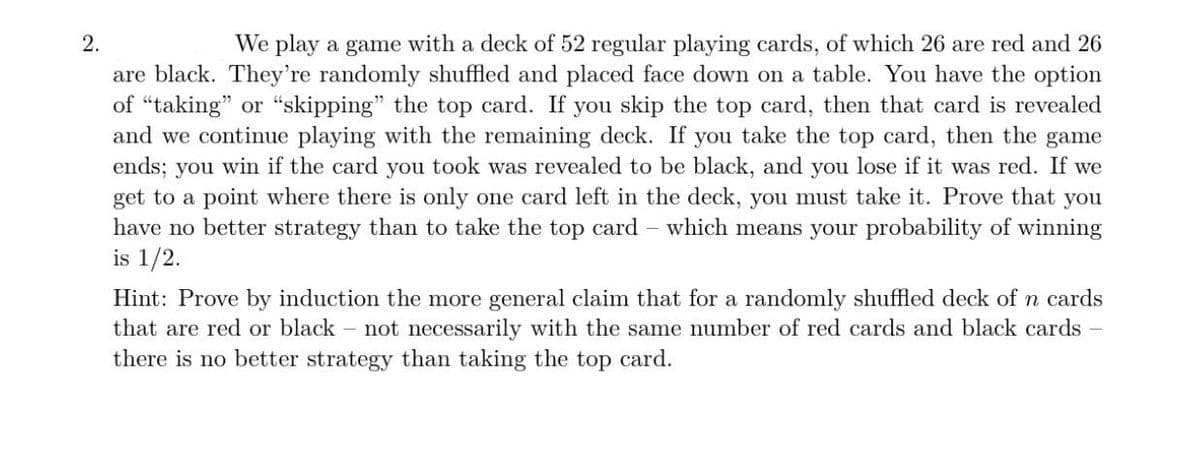2. We play a game with a deck of 52 regular playing cards, of which 26 are red and 26 are black. They're randomly shuffled and placed face down on a table. You have the option of "taking" or "skipping" the top card. If you skip the top card, then that card is revealed and we continue playing with the remaining deck. If you take the top card, then the game ends; you win if the card you took was revealed to be black, and you lose if it was red. If we get to a point where there is only one card left in the deck, you must take it. Prove that you have no better strategy than to take the top card – which means your probability of winning is 1/2.
2. We play a game with a deck of 52 regular playing cards, of which 26 are red and 26 are black. They're randomly shuffled and placed face down on a table. You have the option of "taking" or "skipping" the top card. If you skip the top card, then that card is revealed and we continue playing with the remaining deck. If you take the top card, then the game ends; you win if the card you took was revealed to be black, and you lose if it was red. If we get to a point where there is only one card left in the deck, you must take it. Prove that you have no better strategy than to take the top card – which means your probability of winning is 1/2.
Chapter8: Sequences, Series,and Probability
Section8.6: Counting Principles
Problem 74E: Lottery Powerball is a lottery game that is operated by the Multi-State Lottery Association and is...
Related questions
Question

Transcribed Image Text:2.
We play a game with a deck of 52 regular playing cards, of which 26 are red and 26
are black. They're randomly shuffled and placed face down on a table. You have the option
of "taking" or “skipping" the top card. If you skip the top card, then that card is revealed
and we continue playing with the remaining deck. If you take the top card, then the game
ends; you win if the card you took was revealed to be black, and you lose if it was red. If we
get to a point where there is only one card left in the deck, you must take it. Prove that you
have no better strategy than to take the top card – which means your probability of winning
is 1/2.
Hint: Prove by induction the more general claim that for a randomly shuffled deck of n cards
that are red or black - not necessarily with the same number of red cards and black cards -
there is no better strategy than taking the top card.
Expert Solution
This question has been solved!
Explore an expertly crafted, step-by-step solution for a thorough understanding of key concepts.
This is a popular solution!
Trending now
This is a popular solution!
Step by step
Solved in 2 steps

Recommended textbooks for you


College Algebra (MindTap Course List)
Algebra
ISBN:
9781305652231
Author:
R. David Gustafson, Jeff Hughes
Publisher:
Cengage Learning


College Algebra (MindTap Course List)
Algebra
ISBN:
9781305652231
Author:
R. David Gustafson, Jeff Hughes
Publisher:
Cengage Learning